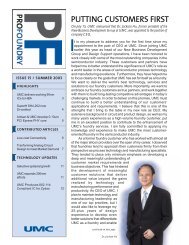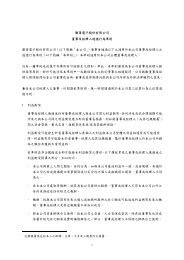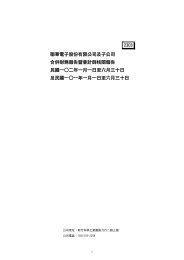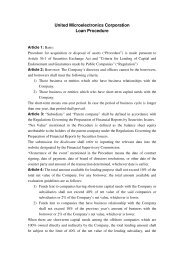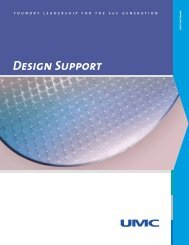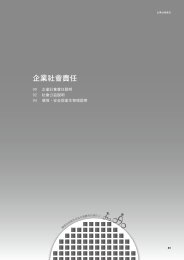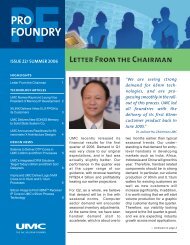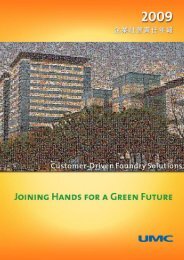90 Nanometer - UMC
90 Nanometer - UMC
90 Nanometer - UMC
Create successful ePaper yourself
Turn your PDF publications into a flip-book with our unique Google optimized e-Paper software.
F O U N D R Y L E A D E R S H I P F O R T H E S o C G E N E R A T I O N<br />
<strong>90</strong> <strong>Nanometer</strong><br />
<strong>90</strong><br />
www.umc.com
<strong>90</strong> <strong>Nanometer</strong><br />
<strong>UMC</strong> has been shipping customer products based on its <strong>90</strong>-nanometer (0.09-um) logic process since March of 2003. Currently, <strong>UMC</strong><br />
is in volume production for a wide range of <strong>90</strong>nm products from multiple customers. <strong>UMC</strong>’s mature <strong>90</strong>nm technology meets a broad<br />
range of market sectors, including wireless RF, baseband, high speed graphics, FPGA, and single chip SoC WLAN products.<br />
<strong>UMC</strong>'s comprehensive SoC solutions for <strong>90</strong>nm include a process technology platform that features multiple transistor options, design<br />
flows and tools, IP solutions that include URAM and e-fuse, DFM resources, fast yield feedback service, and advanced packaging<br />
options.<br />
<strong>UMC</strong>'s <strong>90</strong>-nanometer SoC solution begins with a flexible technology design platform. Customers are able to choose from a variety of<br />
process device options optimized for their specific application, such as High Speed or Low Leakage transistors. Technology options can<br />
then be implemented including mixed signal/RFCMOS and embedded memories to further customize the process.<br />
<strong>90</strong>nm Key Features<br />
• Integrated flows for Logic,<br />
Mixed-Signal/RF<br />
• 1.16 / 0.99um 2 (SWL) SRAM bit cells<br />
• e-Fuse option<br />
• Shallow trench isolation<br />
• Retrograde twin well<br />
(Triple well option)<br />
• 193nm litho for critical layers<br />
• Dual / triple gate dielectric options<br />
• 70nm min. poly length<br />
• Multiple Vt options<br />
• CoSi 2<br />
process<br />
• Up to 1P9M Cu with low-k /<br />
FSG dielectric offerings<br />
• BOAC (Bonding Over Active Circuit)<br />
• Wire Bond / Flip Chip option
Technology to Meet Broad Applications<br />
<strong>UMC</strong> <strong>90</strong>nm Technology<br />
Low Leakage (L<strong>90</strong>LL)<br />
Standard Performance (L<strong>90</strong>SP)<br />
High Speed (L<strong>90</strong>G)<br />
• Portable<br />
• Wireless<br />
• ASIC<br />
• Consumer<br />
• Network<br />
• Graphics<br />
<strong>90</strong>nm Logic/MS/RF Devices<br />
<strong>90</strong>nm Logic/MS/RF Technology<br />
Core Devices<br />
I/O Devices<br />
MS/RF Devices<br />
SP_RVt 1.0V(1.2V)<br />
1.8V I/O<br />
Native Vt<br />
(Thin/Thick Ox.)<br />
SP_LVt 1.0V(1.2V)<br />
2.5V I/O<br />
Bipolar<br />
SP_HVt 1.0V(1.2V)<br />
3.3V I/O<br />
Diodes<br />
LL_RVt 1.2V<br />
Resistor<br />
LL_LVt 1.2V<br />
MIM/MOM *<br />
LL_HVt 1.2V<br />
Varactor *<br />
G_RVt 1.0V(1.2V)<br />
Inductor *<br />
G_HVt 1.0V(1.2V)<br />
Transformer *<br />
SP: Standard Performance LL: Low Leakage G: Graphics : RF Model Available (LL and SP)<br />
*: Not available for <strong>90</strong>G
Silicon Verified IP Solutions<br />
<strong>UMC</strong> offers comprehensive design resources<br />
that enable our customers to fully realize the<br />
advantages of <strong>UMC</strong>'s advanced technologies.<br />
<strong>UMC</strong>'s silicon verified fundamental IPs (standard<br />
cells, I/Os, and memory compilers) help customers<br />
easily migrate their designs to the next process<br />
generation to realize significant performance<br />
advantages while also reducing die size.<br />
Customers can also leverage application<br />
specific IPs that are specialized for all types of<br />
mainstream applications such as digital TVs,<br />
cellular baseband controllers, digital cameras,<br />
and audio players to overcome time-to-market<br />
challenges.<br />
PLL, USB, LVDS,<br />
ADC/DAC,<br />
Embedded<br />
Memory, HDMI,<br />
DDR2<br />
PLL, USB, LVDS,<br />
ADC/DAC,<br />
HDMI, SATA,<br />
Embedded<br />
Memory<br />
DTV<br />
Digital Camera<br />
Mobile DDR, PLL,<br />
ADC/DAC,<br />
LVDS, USB,<br />
Embedded<br />
Memory<br />
PLL, USB, LVDS,<br />
ADC/DAC,<br />
Embedded<br />
Memory<br />
Base Band<br />
Audio Players<br />
Fundamental IP Support for SoC Designs<br />
<strong>UMC</strong> offers comprehensive design resources that support our <strong>90</strong>nm process technology. Silicon verified fundamental IPs (standard<br />
cells, I/Os, and memory compilers) optimized to <strong>UMC</strong> technologies are available free-of-charge from several leading vendors. Customers<br />
can also leverage application specific IPs for DTV, video/audio, etc. IPs available through <strong>UMC</strong> are DFM (Design for Manufacturing)<br />
compliant for better manufacturability.<br />
<strong>90</strong>nm<br />
Library Provider<br />
FARADAY VIRAGE ARM <strong>UMC</strong><br />
Library SP LL SP LL G SP G SP LL G<br />
LVT<br />
Standard Cells<br />
RVT<br />
HVT<br />
I/O<br />
2.5Vdd<br />
3.3Vdd<br />
Single Port SRAM Compiler<br />
Dual Port SRAM Compiler<br />
Single Port Register File<br />
Dual Port Register File<br />
ROM Compiler
Low Power Features of Standard Cell Library<br />
With today's proliferation of low power<br />
applications, lowering energy consumption<br />
without sacrificing performance has<br />
become a critical concern for designers<br />
of power management chips for portable<br />
electronics. <strong>UMC</strong> supports its standard cell<br />
library with low power design features,<br />
Operating<br />
Power<br />
Type<br />
Voltage Island<br />
& Scaling<br />
Clock Gating<br />
& Frequency<br />
Scaling<br />
Support Features<br />
Level<br />
Shifters<br />
w / Insulator<br />
Power &<br />
Timing Model<br />
@ 80% of Vdd<br />
Support<br />
65nm <strong>90</strong>nm 0.13um<br />
Þ Þ Þ<br />
Clock Gated F/F Þ Þ Þ<br />
Multi-Vt Multi-Vt cells Þ Þ Þ<br />
including multiple Vt, clock-gating, level<br />
shifter and other features to complement<br />
Leakage<br />
Power<br />
Power Gating<br />
Isolation cells, Retention F/F<br />
Headers / Footers, etc.<br />
Þ Þ Þ<br />
<strong>UMC</strong>’s complete low power SOC solution.<br />
Body Bias<br />
Tapless cells<br />
Timing / Power<br />
Model<br />
Þ Þ Þ<br />
Low Power Design Support<br />
Front-end design<br />
Low leakage<br />
process<br />
Power<br />
gating<br />
Multi Vth<br />
Multi VDD<br />
Low power<br />
synthesis<br />
Clock<br />
gating<br />
Voltage and<br />
frequency scaling<br />
Body bias<br />
Back-end design<br />
80%<br />
60% 40% 20% 20% 40% 60% 80%<br />
Leakage Power Saving<br />
Dynamic Power Saving
<strong>UMC</strong> Reference Design Flow<br />
<strong>UMC</strong> Reference Design Flow provides a design<br />
methodology and flow validated with a “Leon2”<br />
design. The flow incorporates 3rd-party EDA<br />
vendors’ baseline design flows to address issues<br />
such as timing closure, signal integrity, leakage<br />
power and design for manufacturability and<br />
adopts a hierarchical design approach built upon<br />
silicon validated process libraries. <strong>UMC</strong> Reference<br />
Design Flow covers from schematic/RTL coding<br />
all the way to GDS-II generation and supports<br />
Cadence, Magma, Mentor and Synopsys EDA<br />
tools. All of these tools have been correlated to<br />
<strong>UMC</strong> silicon and can be interchanged for added<br />
flexibility.<br />
I/O & Memory<br />
Simulation View<br />
Timing View<br />
Timing Constraint &<br />
DFT Requirements<br />
Cell Function, Area,<br />
Timing & Power View<br />
Physical & Noise View<br />
DRC/LVS<br />
Rule Deck<br />
Product Definition/Spec & Tech-dependent Setting<br />
RTL Coding & Simulation<br />
Logic Synthesis<br />
Static Timing Analysis & Gate-level Simulation<br />
Floorplan & Partition<br />
Block & Top Implementation<br />
Physical Verification<br />
Tape-out<br />
Reference Design Flow and Vendor Support<br />
<strong>UMC</strong> works with leading EDA tool companies to provide a verified Reference Design Flow program to ensure the accuracy of customer<br />
designs in a proven environment. <strong>UMC</strong> Reference Design Flow program integrates solutions for digital designs and low power<br />
solutions that incorporate the latest DFM resources available from leading third-party providers. Tools can be interchanged for added<br />
flexibility.<br />
Features of Design Flow Cadence Synopsys Magma Mentor Springsoft<br />
Functional Logic Simulation - -<br />
Schematic Entry - - - -<br />
Logic Synthesis - -<br />
Static Timing Analysis - -<br />
Timing Closure - -<br />
Signal Integrity - -<br />
Floor Planning - -<br />
Physical Synthesis - -<br />
Multi-Vt Low Power - -<br />
Multi-Vdd Low Power - -<br />
Design For Test - -
Design Flow and Vendor Support (cont.)<br />
Features of Design Flow Cadence Synopsys Magma Mentor Springsoft<br />
Design For Diagnosis - -<br />
DFM - double via insertion -<br />
DFM - dummy metal filling -<br />
Circuits Simulation - -<br />
Power Analysis - -<br />
Layout Editor - -<br />
Place & Route - -<br />
Physical Verification -<br />
Formal Verification - - -<br />
Parasitic Extraction -<br />
Noise Analysis - -<br />
Note: Available for reference design flow Available for DFM methodology<br />
DFM Methodology<br />
<strong>UMC</strong> offers optimal DFM (Design For<br />
Manufacturability) solutions to effectively DFM Methodology Roadmap<br />
and efficiently address factors that may<br />
negatively affect yield and performance for<br />
Restricted Rules<br />
Statistical timing Analysis<br />
advanced technology designs. <strong>UMC</strong>’s DFM<br />
solutions include advanced process models<br />
Critical Area Analysis<br />
incorporated in SPICE and extraction decks<br />
for predicting random and systematic<br />
variations, technology files, DFM-compliant<br />
Modeling with CMP effects<br />
Litho Simulation Checks<br />
libraries and IP that embrace the intricacies<br />
of the fabrication process. Concise DFM<br />
Modeling with LOD & WPE<br />
recommendation rules are available<br />
along with a comprehensive rule-deck<br />
runset strategy to fulfill various design<br />
Monte Carlo Models<br />
Modeling with WEE<br />
requirements.<br />
DFM Rules<br />
<strong>UMC</strong> also offers pre-tapeout Optical<br />
Proximity Correction (OPC) and Litho Rule<br />
Check (LRC) for custom designs in addition<br />
0.13um <strong>90</strong>nm 65nm 40nm<br />
to our standard post-tapeout services that include OPC, Litho Simulation Check (LSC), dummy fill, and metal slotting. At 65nm and below,<br />
<strong>UMC</strong> offers a DFM Design Enablement Kit (DEK) to seamlessly support model-based DFM tools. The DEK has a built-in Graphic User Interface<br />
(GUI) for DFM design database setup, and is completed with application notes and qualification reports for design reference.
High Density Embedded Memory Solution - URAM TM<br />
To meet the future SoC trend of smaller form factor, higher bandwidth/speed and lower power consumption, <strong>UMC</strong> has developed its own<br />
high density memory solution, URAM, to fulfill market needs. Building on a logic compatible process, URAM adopts trench architecture<br />
as the cell capacitor with no new materials required. This backend-transparent structure also minimizes the backend model impact and<br />
ensures seamless integration with existing IPs. The macro implements the Error Correction Code (ECC) repair scheme with a byte-write<br />
feature to eliminate the need for redundant laser fuse/efuse and enhance the Soft Error Rate (SER). The wide on-chip bus boosts overall<br />
system performance. Pin count can be reduced by eliminating I/O devices, which can also lower the power consumption.<br />
This enabling technology for SoC is now in production for both Standard Performance (SP) and Low Leakage (LL) platforms.<br />
URAM for Broad Applications<br />
Communications<br />
Graphics & Imaging Systems<br />
Storage Devices<br />
Networking, Wireless<br />
Frame Buffer for Image Processors<br />
Cache Memory<br />
<strong>UMC</strong> e-Fuse Features<br />
To reduce chip area, achieve better reliability<br />
performance, and shorten repair time<br />
compared to conventional Al fuse, <strong>UMC</strong><br />
has developed an e-fuse solution to target<br />
the needs of a broad range of applications.<br />
The fuse array and complete functional<br />
macro are offered to ease the integration<br />
process for customers. Both wafer level and<br />
package level fuse are supported. Moreover,<br />
customers can use e-fuse for the OTP (one<br />
time programming) function to save overall<br />
costs.<br />
Logic Compatible<br />
Complete Functional<br />
IP Macros<br />
Design-Friendly Features<br />
Flexibility<br />
• No extra masks necessary<br />
• Only one extra pad required<br />
• Fuse array, programming circuit, sensing amplifier<br />
• Serial and parallel architecture<br />
• Allows metal routing over fuses (M6 and above)<br />
• Programmable at package level<br />
• Wafer level fuse options<br />
• Package level fuse options<br />
Virtual Inductor Library<br />
<strong>UMC</strong> has worked with its EDA tool partners<br />
to deliver the industry's first parameterized<br />
inductor design kit based on full-wave<br />
simulation: the Virtual Inductor Library (VIL).<br />
The VIL enables RFCMOS designers to create<br />
and simulate custom inductor geometries<br />
that are compatible with <strong>UMC</strong>'s processes.<br />
It is built upon <strong>UMC</strong>'s Electromagnetic<br />
Design Methodology (EMDM), which allows<br />
engineers to easily and accurately create<br />
any RF structure. EMDM gives designers<br />
the flexibility to innovate new geometries<br />
simply by editing parameters such as<br />
diameter, number of turns or width.<br />
Spiral<br />
Differential w/o<br />
center tap<br />
Differential with<br />
center tap<br />
The GUI based VIL can be used to simulate all types of RF inductors.<br />
Stack
Virtual Capacitor Library<br />
<strong>UMC</strong> and its EDA tool partners have<br />
delivered the industry's first parameterized<br />
MOM capacitor design kit based on fullwave<br />
simulation: the Virtual Capacitor<br />
Library (VCL). The VCL enables RFCMOS<br />
designers to create and simulate custom<br />
capacitor geometries that are compatible<br />
with <strong>UMC</strong>'s processes. It is built upon <strong>UMC</strong>'s<br />
Electromagnetic Design Methodology<br />
(EMDM), which allows engineers to easily<br />
and accurately create any RF structure.<br />
EMDM gives designers the flexibility to<br />
innovate new geometries simply by editing<br />
parameters such as number of metal and<br />
fingers, arrays, and length of fingers for<br />
capacitor.<br />
The GUI based VCL can be used to simulate all types of RF capacitors.<br />
Virtual Transformer<br />
Library<br />
<strong>UMC</strong> has also worked with its EDA tool<br />
partners to deliver the industry's first<br />
parameterized transformer design kit<br />
based on full-wave simulation: the Virtual<br />
Transformer Library (VTL). The VTL enables<br />
RFCMOS designers to create and simulate<br />
custom transformer geometries that<br />
are compatible with <strong>UMC</strong>'s processes.<br />
It is built upon <strong>UMC</strong>'s Electromagnetic<br />
Design Methodology (EMDM), which allows<br />
engineers to easily and accurately create<br />
any RF structure. EMDM gives designers<br />
the flexibility to innovate new geometries<br />
simply by editing parameters such as<br />
primary impedance, secondary impedance,<br />
number of turns, mode, and frequency for<br />
transformer.<br />
Without Center Tape<br />
CT on secondary coil<br />
CT on primary coil<br />
CT on both coils<br />
The GUI based VTL can be used to simulate all types of RF transformers.
MS/RF Design Flow and<br />
FDK<br />
The FDK (Foundry Design Kit) provides<br />
IC designers with an automatic design<br />
environment. The methodology provides<br />
access to circuit-level design and simulation,<br />
circuit layout, and layout verification with<br />
accurate RF device models. In the frontend,<br />
fundamental components of <strong>UMC</strong>'s<br />
MS/RF process are implemented in common<br />
design environments and simulation tools.<br />
The back-end includes parameterized<br />
cells (P Cell), which include a schematic<br />
driven layout to provide an automatic and<br />
complete design flow. Callback functions<br />
are also provided in the design flow to<br />
minimize data entry. EDA tools for MS/RF<br />
designs are also supported.<br />
Cadence<br />
Schematic (Composer)<br />
(Symbols & CDF)<br />
Schematic<br />
Driven Layout<br />
Circuit Layout<br />
Virtuoso(P-cell)<br />
Verification & Extraction<br />
(DRC/LVS/LPE)<br />
Calibre/XRC<br />
Assura<br />
Tape Out<br />
Virtual Inductor/<br />
Capacitor/Transformer Spec.<br />
Virtual Inductor/<br />
Capacitor/Transformer<br />
Library<br />
Virtual Inductor/<br />
Capacitor/Transformer<br />
Library<br />
Spectre / Spectre RF<br />
Artist<br />
Spectre / Spectre RF<br />
Spectre / Spectre RF<br />
Simulation with Verified<br />
RF/Mixed Signal Models<br />
Optimum Inductor Finder (OIF)<br />
<strong>UMC</strong> offers the Optimum Inductor Finder (OIF) in the FDK package. The OIF gives designers the ability to quickly access a large library<br />
of inductors calibrated to <strong>UMC</strong>'s silicon. It also allows users to perform inductor optimization through just a few simple steps with the<br />
user-friendly interface. For instance, customers can define a desired inductor and make trade-offs between Q-factor and area. The OIF<br />
will select a design that best fits the specifications in a matter of seconds.<br />
Optimum Capacitor Finder (OCF)<br />
<strong>UMC</strong> offers the Optimum Capacitor Finder (OCF) in the FDK package. The OCF gives designers the ability to quickly access a large library<br />
of capacitors calibrated to <strong>UMC</strong>'s silicon. It also allows users to perform capacitor optimization through just a few simple steps with<br />
the user-friendly interface. For instance, customers can define a desired capacitor and make trade-offs between Q-factor and area. The<br />
OCF will select a design that best fits the specifications in a matter of seconds.<br />
Optimum Transformer Finder (OTF)<br />
<strong>UMC</strong> offers the Optimum Transformer Finder (OTF) in the FDK package. The OTF gives designers the ability to quickly access a large library<br />
of transformers calibrated to <strong>UMC</strong>'s silicon. It also allows users to perform transformer optimization through just a few simple steps<br />
with the user-friendly interface. For instance, customers can define a desired transformer and make trade-offs between impedance and<br />
area. The OTF will select a design that best fits the specifications in a matter of seconds.
Analog Design Methodology<br />
FDK EDA Supported Tools<br />
MS/RF<br />
Design Flow<br />
Cadence Mentor ADS Synopsys<br />
SpringSoft<br />
Schematic Entry<br />
Composer<br />
ADS<br />
Laker ADP*<br />
Pre-simulation<br />
Hspice/Spectre<br />
Models<br />
Spectre<br />
SpectreRF<br />
GoldenGate<br />
HSPICE<br />
Physical Design<br />
Virtuoso XL<br />
Laker L3*<br />
Physical<br />
Verification<br />
(DRC/LVS/RCX)<br />
Assura<br />
QRC<br />
Calibre<br />
Calibre XRC<br />
Hercules<br />
Star RCXT<br />
Note: *is available by request<br />
MEMO:
www.umc.com<br />
F O U N D R Y L E A D E R S H I P F O R T H E S o C G E N E R A T I O N<br />
New Customers<br />
For new customer inquiries,<br />
please direct all questions to<br />
sales@umc.com<br />
Worldwide Contacts<br />
Headquarters:<br />
<strong>UMC</strong><br />
No. 3, Li-Hsin 2nd Road,<br />
Hsinchu Science Park,<br />
Hsinchu, Taiwan, R.O.C.<br />
Tel: 886-3-578-2258<br />
Fax: 886-3-577-9392<br />
Email: foundry@umc.com<br />
In China:<br />
<strong>UMC</strong> Beijing:<br />
Room #521, 5F, South Block,<br />
Raycom InfoTech Park, No.2,<br />
Kexueyuan South Road,<br />
Zhongguancun,<br />
Haidian District,<br />
Beijing 1001<strong>90</strong>, China<br />
Tel: 86-10-59822250<br />
86-18913138053<br />
Fax: 86-10-59822588<br />
HeJian Technology (Suzhou):<br />
No. 333, Xinghua Street, Suzhou<br />
Industrial Park, Suzhou, Jiangsu<br />
Province 215025, China<br />
Tel: 86-512-65931299<br />
Fax: 86-512-62530172<br />
In Japan:<br />
<strong>UMC</strong> Group Japan<br />
15F Akihabara Centerplace Bldg.,<br />
1 Kanda Aioi-Cho Chiyoda-Ku<br />
Tokyo 101-0029 Japan<br />
Tel : 81-3-5294-2701<br />
Fax: 81-3-5294-2707<br />
In Singapore:<br />
<strong>UMC</strong>-SG<br />
No. 3, Pasir Ris Drive 12,<br />
Singapore 519528<br />
Tel: 65-6213-0018<br />
Fax: 65-6213-0005<br />
In Korea:<br />
<strong>UMC</strong> Korea<br />
1117, Hanshin Intervally24, 322,<br />
Teheran-ro, Gangnam-gu,<br />
Seoul, Korea<br />
Tel: 82-2-2183-17<strong>90</strong><br />
Fax: 82-2-2183-1794<br />
Email:korea@umc.com<br />
In North America:<br />
<strong>UMC</strong> USA<br />
488 De Guigne Drive,<br />
Sunnyvale, CA 94085, USA<br />
Tel: 1-408-523-7800<br />
Fax: 1-408-733-80<strong>90</strong><br />
In Europe:<br />
<strong>UMC</strong> Europe BV<br />
De entree 77<br />
1101 BH Amsterdam Zuidoost<br />
The Netherlands<br />
Tel: 31-(0)20-5640950<br />
Fax: 31-(0)20-6977826<br />
For more information: visit www.umc.com or e-mail sales@umc.com<br />
1404



